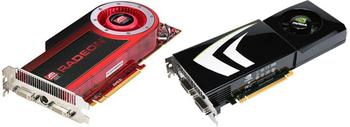Introduction
It was way back in June 2008 that AMD revitalised its graphics card line up with the launch of the Radeon HD 4870. Back then, the 512MB card arrived with a 242 per cent increase in arithmetic processing when compared to its predecessor, the Radeon HD 3870. Priced a fraction under the £200 mark, AMD's Radeon HD 4870 - and the lesser Radeon HD 4850, we might add - had gamers the world over rubbing their hands and wallets in anticipation.
In response, NVIDIA gave its own "affordable" high-end card - the GeForce GTX 260 - a makeover back in September by raising the number of stream processors from 192 to 216. The result was a card that provided Radeon HD 4870-matching performance for roughly the same asking price.
Now, in 2009, the graphics market has changed dramatically as a result of the dwindling economy. Products that launched some seven months ago - AMD's Radeon HD 4870, for example - have barely budged in price and in some cases have found themselves becoming more expensive than when first introduced.
It's an unusual situation, so we've decided to take another look at the two competing products - AMD's Radeon HD 4870 (pictured below, left) and NVIDIA's GeForce GTX 260 (pictured below, right).
Today, both cards are available in partner-enhanced form at a cost of roughly £230, and of course with updated driver releases that boast numerous improvements in frame-rate performance.
To find out how they fare in today's marketplace, with current pricing and performance, we'll be putting GIGABYTE's Radeon HD 4870 1GB head to head with Inno3D's GeForce GTX 260 OC. Looking to spend just under £250 on a graphics card? Read on.



